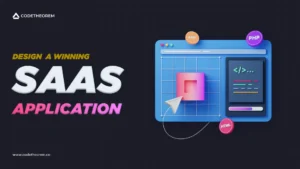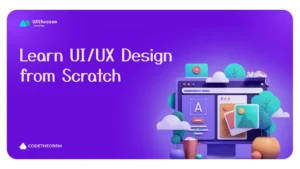Regardless of the industry, you work in; you might have heard the term design thinking. Earlier, design thinking was primarily used to create new technology and products. However, today, it is widely used across creative industries. So, if you wonder what it means and want to learn and gain insight into it, continue reading.
This blog will walk you through everything there is to learn about design thinking – evolution, principles, process, and application. But before we get to the specifics, let’s understand what is design thinking.
Article content
What is Design Thinking?
Design thinking is a process of solving problems, prioritizing the consumer’s needs above all else. The design thinking process relies on observing how people interact with their environments with empathy. Moreover, it employs a hands-on approach to crafting innovative solutions.
Design thinking is “human-centric,” meaning it uses evidence of how consumers literally engage with a product or service. It does not let someone elses’ or an organization’s perception of how the consumers would engage with it hamper its notion. To be genuinely user-centric, UX designers observe how people use a product or service and keep refining it to improve the user experience. Hence, it can be said the process is iterative. It supports getting prototypes out to test quickly instead of ongoing research or rumination.
Unlike traditional problem-solving, which is a linear process of identifying a problem and then brainstorming solutions, designerly thinking only works if it is iterative. It is a way to evolve your thinking and respond to consumer needs continuously.
Evolution of Design Thinking
It’s challenging to list all the influential factors that led to the contemporary understanding of the design thinking process and practice. Business analysts, creative individuals, and engineers have studied innovation’s design methods and processes for decades.
Design thinking dates back to the 1950s and 1960s, majorly within architecture and engineering. These were the fields that struggled to keep up with the rapidly changing environment of that era.
Although the roots of the famous process go way longer, we’ll talk about a few significant events from then until now. But before we get to that, it’s essential to learn that it all started with people first applying scientific methodology and processes to understand every aspect of design. They struggled with that throughout the decade and ultimately made further attempts to make the designs scientific.
The mid-1960s – The Wicked Problem
In the mid-1960s, Horst Rittel wrote and spoke extensively about problem-solving in design. Therefore he’s known as the design theorist who coined the term “wicked problem.” It‘s a term used to describe multidimensional and highly complex problems.
Wicked problems are considered at the very heart of the process because they require a collaborative methodology to gain an immersive understanding of humans’ needs, motivations, and behaviour.
1970 – Design as a Way of Thinking
In 1970, Cognitive scientist and Nobel Prize laureate Herbert A. Simon mentioned design as a way of thinking in his book, The Sciences of the Artificial. It was then that people tried perceiving design as a way of thinking too. Herbert also contributed many ideas throughout the 1970s, now known as the design thinking principles.
Furthermore, he also introduces the concept of rapid prototyping. As he said, “To understand them, the systems had to be constructed, and their behaviour observed.” Surprisingly, a large proportion of his work at the time was focused on developing artificial intelligence and analyzing whether human forms of thinking could be synthesized. If you think for a moment, you’ll realize that it’s a prevalent topic in the design world today.
The 1980s – Solution-Focused Problem Solving
Moving to 1982, Nigel Cross then compared designers’ problem-solving processes to the non-design-related solutions being developed for problems in our everyday lives. Furthermore, Bryan Lawson, Emeritus Professor at the School of Architecture, University of Sheffield, UK, conducted a series of tests.
The main goal of the tests was to compare the methods used by scientists and architects to solve the same ambiguous problem. That is when he discovered that scientists were problem-focused problem solvers, while designers were and still are solution-focused problem solvers. The designers choose to generate many solutions and eliminate those that don’t work.
From here onwards, design thinking became a separate concept and created a space of its own.
1991 – IDEO
This is when a design and innovation company – IDEO, emerged and brought design thinking into the mainstream. Over the years, they were the first to develop their customer-friendly terminology, steps, and toolkits. Not keeping it limited to just themselves, they made the process accessible to those not versed with UX design methodology.
2004 – d.School
In 2004, David Kelley founded the Hasso Plattner Institute of Design at Stanford. It is popularly recognized as the d.school. Since it was established, the d.school made developing, teaching, and implementing design ideology one of its central objectives. Today, d.School serves as a source of immense inspiration to design thinkers worldwide.
Present Time
At the current time, design thinking is rapidly gaining ground. Pioneers like IDEO and the d.school have paved a path for various creative individuals, firms, and businesses across several industries to follow. Even many prestigious universities and business schools have also adopted the design thinking mindset to varying degrees.
Why is Design Thinking Important?
Thinking like a designer can drastically transform how your organization develops products, processes, and strategies. It enables you to think from the customer’s perspective and create products and services that are technologically feasible and economically viable.
Crafting user-centric design and solutions requires a new way of thinking. One that goes beyond bits and data to include the human perspective or design experience. 2022 is the year when software engineers and data scientists join forces with design experience professionals to understand various human problems that need to be solved and develop effective solutions. A report from McKinsey indicates that organizations that regularly follow the design thinking approach see third higher revenues and 56% higher returns than those that don’t.
The firms that follow a design-driven culture don’t have to be afraid of design mistakes or launching a product that is not totally perfect. They can enter the market with an MVP (minimally viable product), learn from the customer behaviour, actions and feedback, and incorporate the same to build and release the next, better version of the product. One of the best examples here can be Instagram. IG first launched a product, then learning which features got famous over time, they re-launched a new version. As a result, there were 100,000 downloads within a week.
Design Thinking Principles
Following are the main 5 design thinking principles;
1. Empathy
This creative process is about finding effective solutions that align with users’ needs and feedback. People are the drivers of innovation, not technology. Therefore, a vital part of the design thinking framework involves peeking into the users’ thought window and building genuine empathy for your target audience.
2. Collaboration
The objective of this creative problem-solving process is to enable you to come up with a diverse variety of perspectives and ideas for innovation! It encourages collaboration between various multidisciplinary teams that typically don’t work together.
3. Ideation
Design thinking is a solution-based framework. Hence, the main focus here is to come up with as many ideas and potential solutions as possible. It’s worth noting that ideation is both a core design thinking principle and a critical step in the design thinking process. This step works like a judgment-free zone where participants must focus on the number of ideas rather than the quality.
4. Experimentation and Iteration
Design intelligence doesn’t just involve coming up with ideas; but also about turning them into prototypes, testing them, and improving them based on user feedback. It is an iterative approach that repeats specific steps in the process as you uncover shortcomings in the early versions of a proposed solution.
5. A Bias Towards Action
Design thinking is a hands-on approach to problem-solving. It favours action over a discussion. Instead of assuming what your users want, it encourages you to get out and engage with them face-to-face. Rather than just simply talking about potential solutions, it enables you to turn them into tangible prototypes and test them in real-world contexts.
Design Thinking Process
The design thinking framework comprises 5 design thinking phases, which can act like a design sprint. They are as follows:
1. Empathize
The first phase of this creative problem-solving process is empathy. It enables you to gain an insight into the problem. However, more than understanding the problem, empathy is critical to understanding the user’s requirements to deliver a tailored solution. This step entails observation and engagement with the user. It helps understand their behaviour, patterns, preferences, and reactions to different situations. Furthermore, you can tailor solutions to fit user needs when you fully grasp the user environment and behavioural patterns.
2. Define
The next in the list of design thinking phases is organizing all the information gathered during the previous step. This exercise will help you define the problem statement from a more user-centric perspective. The define stage enables you to break down vague ideas and issues and form a structured approach toward solving them. This is when you draft the plan and frame questions that need to be answered to resolve the problem.
3. Ideate
Throughout the process, this is the most crucial stage of all. Ideation offers much room for creativity, which is where it gets interesting. You think radically and prepare for experimentation to build an excellent user experience here. It’s essential to come up with fresh perspectives at this stage and think of innovative ways of resolving the issue. Moreover, it’s important to consider obstacles from the user’s end and the environment while suggesting these solutions.
4. Prototype
Prototyping necessitates grouping your best ideas and putting them into shape. This stage allows you to test the effectiveness of your solution in a small-scale environment before presenting it for application. You can execute all the probable solutions at this stage and check for their effectiveness.
An essential part of this phase is eliminating all the failed, less-effective options and moving ahead with the best ones. Furthermore, prototyping helps you understand how users typically behave or react to a particular solution. Thereby helping you form more realistic solutions that can be adopted on a larger scale.
5. Test
The final stage of the process entails testing the best solutions. Since it is an iterative methodology, you can use the results of this stage to refine the end solution further. Often, the solutions you identify in this phase undergo significant changes to fit the real environment user needs. Some are even discarded. The end result of this phase then turns out to be a tried and tested solution that endures user expectations and environmental hindrances.
How Do Companies Benefit From Design Thinking?
The following are some significant ways companies can benefit by following the design thinking process or the design thinking approach:
1. Overcome Design Challenges
Companies get the freedom to have a look at problems from several perspectives. This gives birth to various complex and creative issues. Following a design process enables companies to overcome these design challenges efficiently and effectively.
2. Effectively Meet the Customers’ Requirements
As discussed earlier, design thinking entails developing various prototypes where you perform user testing and implement the customers’ feedback iteratively to ensure quality. By following the design thinking approach effectively, companies can eventually build a product that meets the customers’ requirements.
3. Broaden Your Knowledge
Companies have to perform numerous evaluations while undergoing the design thinking process. They always have to improvise their model by implementing the customer’s feedback to ensure customer satisfaction. It involves putting in a lot of brainwork to bring out the best ideas, which helps broaden their knowledge.
Design Thinking Examples Across Industry
Today, design thinking applications are spread across various professions and industries. From sports to education, study to UX research, and business to management, the process is actively used by several organizations worldwide.
Here are a few design thinking examples across various industries to help you get a better understanding.
1. Business
The notion and the process is most popular among businesses. It helps them optimize processes, especially for product creation, contract renewal, and marketing. Given that the design thinking process requires a good amount of focus on the customers, it is beneficial when it comes to assisting them. In businesses, design intelligence helps a design thinker not only develop deep empathy for their customers but also to create solutions that meet their specific needs.
2. Information Technology
The IT industry is one of those industries that requires a lot of products to undergo trials and proof of concept. Hence, the industry needs to empathize with its users instead of simply deploying technologies. IT is not just about technology or products but also processes. The developers, analysts, consultants, and managers must brainstorm possible solutions for the client’s problems. This is where design thinking benefits a ton.
3. Entertainment – Netflix
Although many companies have successfully incorporated designerly ways of knowing, thinking and acting, Netflix is an OTT platform that has repeatedly leveraged it to become a giant. It is one of the most relevant design thinking examples to consider. During the company’s establishment, its primary competitor, Blockbuster, required customers to visit brick-and-mortar stores to rent DVDs. The process was precisely the same for returns, a significant pain point for many. Netflix came up with a solution and eliminated that inconvenience, delivering DVDs directly to customers’ homes with a subscription model.
While this was a revolution for the movie industry, Netflix’s real success has always been in its innovation. For example, as soon as the company realized DVDs were becoming outdated, it developed an on-demand streaming service to stay ahead of the curve. This way, they could eliminate the inconvenience of having to wait for DVDs unwittingly.
Furthermore, it responded to customers’ demand for original, provocative content that wasn’t airing on traditional networks. Next, in 2016, Netflix further improved its user experience by adding short trailers to its interface. This shows that each of Netflix’s significant updates responded to customers’ needs and was driven by an effective design thinking process.
4. Airbnb
One of the excellent design thinking examples is Airbnb. The company started by making around $200 a week. After some observation, the founders recognized that the advertising pictures that hosts post online aren’t of a high enough quality. This would often stop customers from renting rooms.
To empathize with customers, the founders travelled to every location, imagining what users would want to look for in a temporary place to stay. They then decided to invest in a high-quality camera and take pictures of what customers wanted to see. For example, showing every room instead of the selected ones, listing special features in the description, and highlighting the neighbourhood or areas nearby. The result? A week later, the company enjoyed double revenue.
Conclusion
Now that you know what design thinking is and how critical it is in the current time, you must try implementing it too. Step into your users’ shoes to improve your product’s value and overall user experience.


















